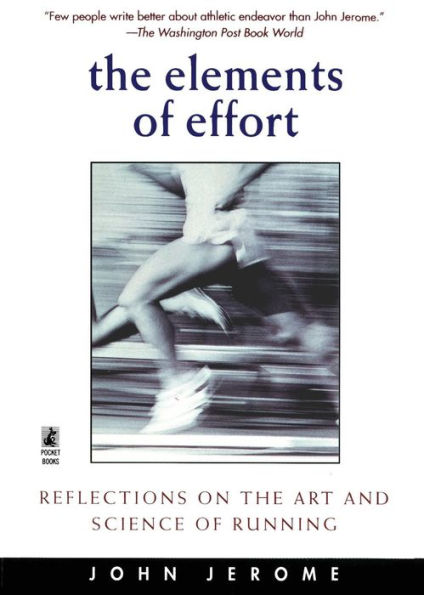Read an Excerpt
The Elements of Effort
Reflections on the Art and Science of Running
By John Jerome Pocket
Copyright © 1997 John Jerome
All right reserved. ISBN: 0-671-02370-5
Introduction
The heart is the tachometer of effort.
A lot of writers I know keep a small book called The Elements of Style on a shelf right over their desks. Only seventy-one pages long, it is a perfect gem of advice on clear composition, and an entertaining read in the bargain. It's handy to have around.
It was written by William Strunk Jr., a professor of English at Cornell, in 1918, intending "merely to give in brief space the principal requirements of plain English." One of Strunk's students was E. B. White, who went on to become one of the most graceful essayists in American letters. In 1959, White revised what Will Strunk always called his "little book," added an introduction, and had it republished. It has never since gone out of print. Writers refer to simply it as "Strunk and White."
As a runner and a writer I've always thought we needed a similar basic guide to the principles of athletic training. Ideally it would be expressed not in the Tab-A-in-Slot-B manner of most exercise physiology texts, but with a little more sympathy for the reader - a sentiment acquired from Strunk and White. "Will felt that the reader was in serious trouble most of the time," said White, "a man floundering in a swamp, and thatit was the duty of anyone attempting to write English to drain the swamp quickly and get his man up on dry ground, or at least throw him a rope."
For fourteen years I've written The Complete Runner's Day-by-Day Log and Calendar. In composing the monthly essays for the Log, I've tried to gather the most useful principles of athletic effort, weave them into a comfortable form, and link them to the larger phenomenal world in which we run. The principles do not represent all one might ever possibly want to know about athletic training, but if your eyes tend to glaze over at discussions of V[O.sub.2] max - or yet another formula for computing the heart-rate range at which the training effect allegedly kicks in - what follows is an attempt to toss you a few of Will Strunk's handy ropes.
Runners are able to run because the body turns food into a molecule that comes with a kind of magnet attached to it. The magnet, a free phosphate radical, leaps to make new attachments, and in that leap releases energy, which powers muscle, which drives us down the road. This may not be the most interesting transaction in the world - except perhaps for chemistry majors - but its elemental nature is worth keeping in mind.
Running is the most elemental sport there is. We are genetically programmed to do it. One might even say we are the free-ranging, curious, restless creatures that we are because of running. Surely our instinct for freedom is a legacy of this essential mobility.
I think freedom itself is the source of running's great appeal. Slip on a pair of shoes, slip out the door, and you're there: free. No commute to a playing field, no teams or uniforms, no dates to arrange. No score-keeping, no rules, no fancy equipment to buy. Try though the gimmicksellers have to complicate the sport, nothing has compromised running's essential simplicity.
Simplicity, however, is a quality that, in human affairs, is difficult to hang on to. As instinctively as we are driven to run free, we are also driven to analyze and assess, to pry apart, to deeply know. Just as we have marketeers dreaming up new running fads and fashions, we have scientists - and a thousand treadmills - searching out the innermost secrets of human performance, and coaches shepherding their guinea-pig athletes through practical trials of those secrets. We can't possibly know too much about a given subject - to claim that is to deny our curiosity, which is an essential part of our humanness - but sometimes it feels as if we do. The Elements of Effort is intended as a celebration of running's original simplicity. It is an attempt to illustrate, in familiar essays, the elemental aspects of running.
You do every day's run on your feet, but you also do it in your head. The pieces that follow acknowledge that fact; they are therefore unapologetically personal, as personal as I can make them. Each is a line of thought that came to me while running, that gave me a chance to let my mind go off and play. I hope you'll find in them a suitable collection of ideas to mull over in the course of your own daily runs.
The Log from which many of the ideas in this book spring was originated by Jim Fixx in 1979, two years after he published his masterpiece, The Complete Book of Running. That was easily the most popular running book of all time, and after more than twenty years is still the one responsible for getting most of us started in the first place. The Elements of Effort is dedicated to Jim's memory.
- John Jerome
(Continues...)
Excerpted from The Elements of Effort by John Jerome Copyright © 1997 by John Jerome. Excerpted by permission.
All rights reserved. No part of this excerpt may be reproduced or reprinted without permission in writing from the publisher.
Excerpts are provided by Dial-A-Book Inc. solely for the personal use of visitors to this web site.



